Water is a fundamental need for survival, deeply intertwined with each aspect of human life – health, food security, energy, and even climate change. However, the distribution of this vital resource is far from even. Across the globe, the cruel irony persists that while water is present in abundance, its access is denied to billions of people, primarily as a direct result of poverty. This intersection between water scarcity and poverty constitutes the “Water-Poverty Nexus”. This article delves into this critical issue, identifies the links that perpetuate this cycle of deprivation, and explores potential solutions to break this vicious cycle.
The Water-Poverty Connection
Broadly speaking, those who lack access to clean water and sanitation services are often the same people grappling with poverty. This is mainly due to the fact that adequate water infrastructure needs economic resources to build and maintain. Water also plays a critical role in economic activities, particularly agriculture, which sustains many low-income communities. This implies that the lack of water can directly contribute to and perpetuate poverty, forming the water-poverty nexus.
The Consequences of the Water-Poverty Nexus
The water-poverty nexus perpetuates a cycle of deprivation in several ways, impacting the most vulnerable communities the hardest.
Health implications: Lack of access to clean water leads to poor hygiene and increased risk of diseases such as cholera, dysentery and typhoid. Globally, an estimated 297,000 children under five die annually from diarrhoea as a result of poor sanitation, poor hygiene, or unsafe drinking water[^1^]. Illness further exacerbates poverty by reducing school attendance and work capacity.
Lost economic opportunities: Safe water access is critical for activities that drive local economies – such as farming, fishing, and small businesses. Water scarcity can limit these activities, and by extension, economic growth.
Education and gender disparity: Women and girls often bear the burden of fetching water in water-scarce communities, walking kilometers daily. This takes time away from education and other productive activities, perpetuating gender disparities and ultimately impacting the community’s development.
Breaking the Vicious Cycle
A multi-faceted approach is needed to break the water-poverty cycle, considering both the supply and demand aspects of the issue.
Investment in water infrastructure: To ensure reliable access to water, significant capital investment in water infrastructure is essential. This includes not only the building of new facilities but also the critical maintenance of existing ones.
Innovative financing mechanisms: Given that public funds are often insufficient to meet the vast needs for water infrastructure, alternative financing mechanisms have to be explored. These could range from regional development banks, impact investing to public-private partnerships.
Community involvement: Community-led initiatives have shown promise in managing local water resources efficiently. Empowering communities to take a lead ensures services are designed to meet their specific needs and are hence more sustainable in the long run.
Water stewardship: Encouraging businesses to adopt responsible water practices can relieve stress on local water resources. This aspect of corporate social responsibility implies using water efficiently and supporting initiatives to improve access to water in their areas of operation.
Climate change adaptation: With climate change exacerbating water scarcity, it brings a new urgency to these efforts. Policies must be designed to maintain the resilience of water resources in the face of climatic uncertainties.
The water-poverty nexus is a complex challenge that extends beyond mere access to water. It represents an intersectional problem that is tangled with socio-economic and environmental circumstances. Therefore, solving it involves not just improvements in water services, but also broader efforts to reduce poverty and implement sustainable development.
While the task is undeniably monumental and challenging, the ultimate rewards are worth the effort. Breaking the water-poverty cycle can unlock a world of opportunity for the world’s most vulnerable people, catalyzing progress towards a more prosperous, equitable, and sustainable world.
[^1^]: United Nations Water – Water, Sanitation and Hygiene
[^2^]: World Health Organization – Water Poverty

